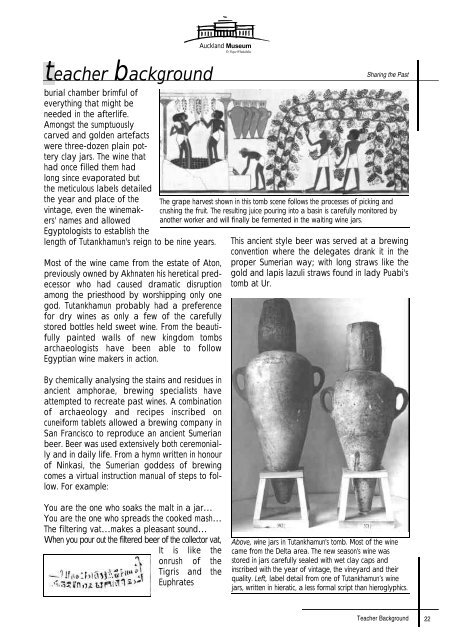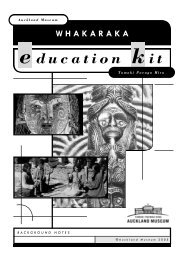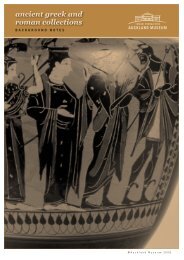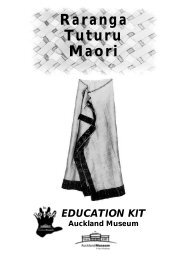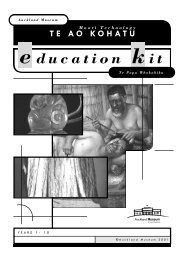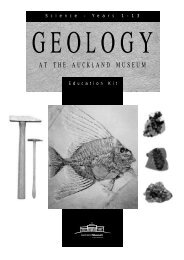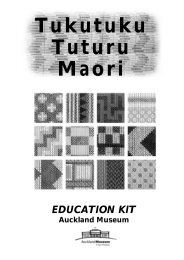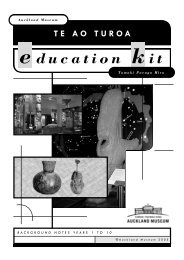You also want an ePaper? Increase the reach of your titles
YUMPU automatically turns print PDFs into web optimized ePapers that Google loves.
teacher background<br />
burial chamber brimful of<br />
everything that might be<br />
needed in <strong>the</strong> afterlife.<br />
Amongst <strong>the</strong> sumptuously<br />
carved and golden artefacts<br />
were three-dozen plain pottery<br />
clay jars. The wine that<br />
had once filled <strong>the</strong>m had<br />
long since evaporated but<br />
<strong>the</strong> meticulous labels detailed<br />
<strong>the</strong> year and place of <strong>the</strong><br />
vintage, even <strong>the</strong> winemakers'<br />
names and allowed<br />
Egyptologists to establish <strong>the</strong><br />
length of Tutankhamun's reign to be nine years.<br />
Most of <strong>the</strong> wine came from <strong>the</strong> estate of Aton,<br />
previously owned by Akhnaten his heretical predecessor<br />
who had caused dramatic disruption<br />
among <strong>the</strong> priesthood by worshipping only one<br />
god. Tutankhamun probably had a preference<br />
for dry wines as only a few of <strong>the</strong> carefully<br />
stored bottles held sweet wine. From <strong>the</strong> beautifully<br />
painted walls of new kingdom tombs<br />
archaeologists have been able to follow<br />
Egyptian wine makers in action.<br />
By chemically analysing <strong>the</strong> stains and residues in<br />
ancient amphorae, brewing specialists have<br />
attempted to recreate <strong>past</strong> wines. A combination<br />
of archaeology and recipes inscribed on<br />
cuneiform tablets allowed a brewing company in<br />
San Francisco to reproduce an ancient Sumerian<br />
beer. Beer was used extensively both ceremonially<br />
and in daily life. From a hymn written in honour<br />
of Ninkasi, <strong>the</strong> Sumerian goddess of brewing<br />
comes a virtual instruction manual of steps to follow.<br />
For example:<br />
You are <strong>the</strong> one who soaks <strong>the</strong> malt in a jar…<br />
You are <strong>the</strong> one who spreads <strong>the</strong> cooked mash…<br />
The filtering vat…makes a pleasant sound…<br />
When you pour out <strong>the</strong> filtered beer of <strong>the</strong> collector vat,<br />
It is like <strong>the</strong><br />
onrush of <strong>the</strong><br />
Tigris and <strong>the</strong><br />
Euphrates<br />
<strong>Auckland</strong> <strong>Museum</strong><br />
Te Papa Whakahiku<br />
Sharing <strong>the</strong> Past<br />
The grape harvest shown in this tomb scene follows <strong>the</strong> processes of picking and<br />
crushing <strong>the</strong> fruit. The resulting juice pouring into a basin is carefully monitored by<br />
ano<strong>the</strong>r worker and will finally be fermented in <strong>the</strong> waiting wine jars.<br />
This ancient style beer was served at a brewing<br />
convention where <strong>the</strong> delegates drank it in <strong>the</strong><br />
proper Sumerian way; with long straws like <strong>the</strong><br />
gold and lapis lazuli straws found in lady Puabi's<br />
tomb at Ur.<br />
Above, wine jars in Tutankhamun's tomb. Most of <strong>the</strong> wine<br />
came from <strong>the</strong> Delta area. The new season's wine was<br />
stored in jars carefully sealed with wet clay caps and<br />
inscribed with <strong>the</strong> year of vintage, <strong>the</strong> vineyard and <strong>the</strong>ir<br />
quality. Left, label detail from one of Tutankhamun’s wine<br />
jars, written in hieratic, a less formal script than hieroglyphics.<br />
Teacher Background<br />
22


